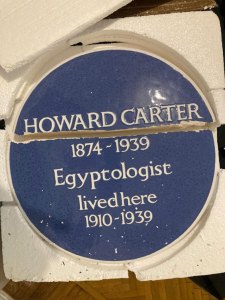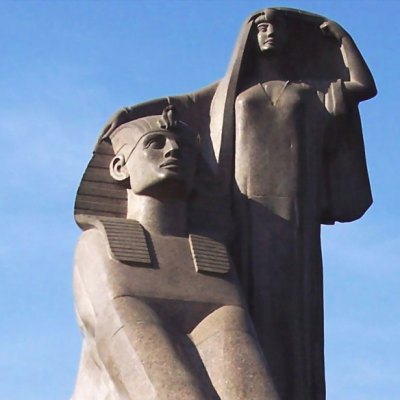Introducing Rakewell, Apollo’s wandering eye on the art world. Look out for regular posts taking a rakish perspective on art and museum stories.
In early November, precisely a hundred years after the discovery of the tomb of Tutankhamun in the Valley of the Kings, Howard Carter’s mudbrick house in Luxor reopened after renovation and restoration undertaken by the American Research Center in Egypt.
Final preparations were thrown into genteel turmoil a few days before the opening. The British Embassy in Cairo had funded a ceramic blue plaque to adorn the entrance to the site, inspired by one that English Heritage had placed on Carter’s London home 20 years earlier. All information in Carter House is bilingual – a first for the site – and the blue plaque was to be paired with a green plaque made in Cairo and inscribed in Arabic calligraphy. The blue plaque was designed, sculpted, biscuit fired, glazed, fired again, and despatched to Cairo in the diplomatic bag. It broke very neatly in transit.
A shattering discovery: the plaque unpacked. Photo: Rakewell’s own, possibly

Conservators Bianca Madden and Augustin Gamarra worked against the clock to reattach the pieces, fill the losses, and repaint them to copy the missing glaze. Final re-touches were carried out in situ the day before the opening, and – until a replacement arrives – only the keenest-eyed visitors will be likely to notice the patches of restoration on the plaque. Pharaoh’s curse was quickly invoked. Since Howard Carter received no official recognition in the UK for his great discovery, however, if a supernatural explanation has to be sought it seems just as likely to have been Carter’s own sardonic comment on the centenary. The mishap will be immortalised online, since the 3D scan of the site will keep depicting a bare wall awaiting the plaque.
Grand openings in Egypt are no strangers to delay and last-minute hitches. The record is currently held by the restoration in 2010 of the Museum of Islamic Art in Cairo, which was entirely redecorated a few days before the opening on the instructions of Farouk Hosni, the Minister for Culture at the time. The museum’s white walls did not meet with his approval on the pre-opening walkthrough, and they were hastily painted a fetching, albeit unrelated, dark grey for the opening celebrations. Strong competition for the crown can be anticipated from the opening of the Grand Egyptian Museum, first scheduled for 2012 and currently slated for 2023.
Howard Carter’s house in Luxor. Photo: Rakewell’s own, possibly

The inauguration of Carter House included ambassadors galore and the current Lord and Lady Carnarvon (who were put up in a suite at the Winter Palace, following family custom, while Egyptologists slummed it at the Sonesta). Members of the family of Morcos Pasha Hanna, the Egyptian minister for public works who evicted Carter from the tomb in 1924 also flew in from Cairo and California. Ahmed Grigar, nonagenarian descendant of one of Carter’s excavation supervisors, made the short journey from his house in Luxor. Beyond the razzmatazz (which climaxed with a surf ‘n’ turf, son et lumière dinner at Luxor Temple), the presence of participants from all sides of the Tutankhamun story at the restoration of Carter House might signal a century of newer approaches to Tutankhamun.
Got a story for Rakewell? Get in touch at rakewell@apollomag.com or via @Rakewelltweets.



